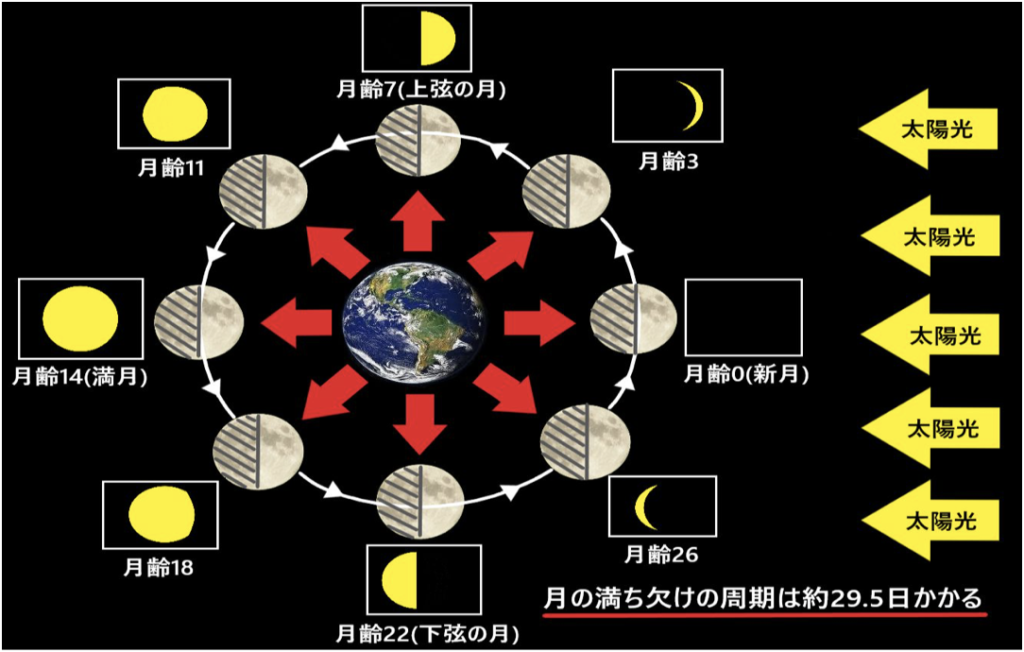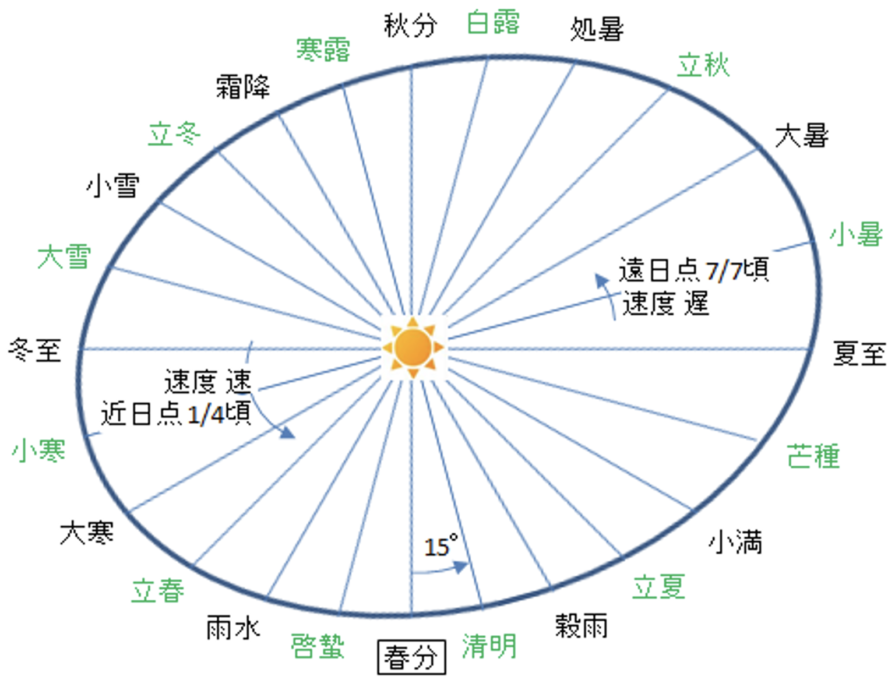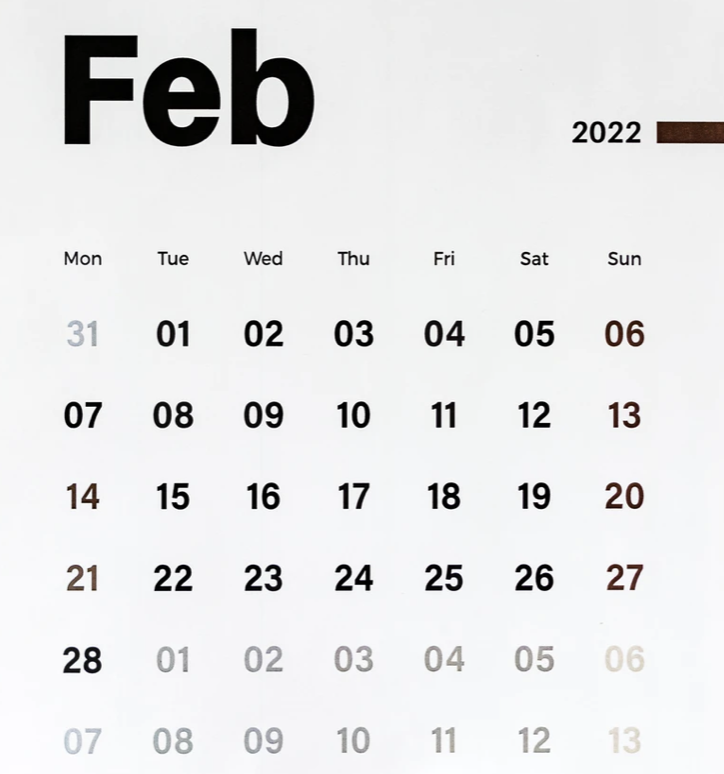はじめに
TED-Edの動画にはまっている。今回は「なぜ2月は28日なの?」という暦に関する動画だ。暦には謎が多い。なぜ1週間は7日なのか。なぜ1年は12ヶ月なのか。誰が決めたのか?そんなことに興味がある人は是非視聴してみてほしい。
太陰暦と太陽暦
今回はアニメではなく、男性が早口で捲し立ていて、正直難解だった。何度聞いてもよく分からない。暦を考える上で、人間が考えることと、大自然の動きは分けて考える必要がある。
月齢
これは今回の主題ではないけど、月の満ち欠けの周期(月齢)は29.5日だ。しかし、厳密にいえば、地球の自転と月の公転が同じ向きなので、公転の周期は27.3日と2.2日のずれがある。まあ、地球に住んでいる人間から見ると、一月が約30日というのは自然な発想だろい。なので日本語では月と言うし、英語でもmonthとmoonの派生語を使っている。

(出典:ギモン雑学)
1年の周期(公転)
地球が太陽の周りを1周する周期が1年だ。1年は365.24218944と言う。地球は23.4度と言う傾きを持って自転しながら太陽の周りを回っている。下の図に示すように、北半球の夏(7月の小暑)は実は太陽が最も遠く、冬(2月の小寒)では最も近くなっている。問題は、1年の約365.232日を月の29.5日で割ると12.38日となり、12ヶ月だと足りないことだ。

(出典:shirotaka)
ユリウス暦
アジア諸国は太陰暦から太陽暦に変更しているが、昔は太陰暦を使っていた。同様に、初期のローマも太陰暦だった。ロミュロン共和国では3月に始まり、12月に終わる30日もしくは31日の10ヶ月で、残り61日と4分の1日は数えていたなかったという。動画の中で、ローマの二代目の王ヌマ・ポンピリウスは、古代ローマでは偶数は不吉とされていたので、1年を355日して、細かな足し引きをして、結果的に2月を28日にした。しかし、太陽の周期と異なるので、社会的な混乱が発生した。ジュリアス・シーザは、365日暦が流行っていたエジプトに滞在していたので、紀元前46年には、太陽暦を導入し、1月をスタートの月にした。また、閏日を4年ごとに1日追加した。1582年には、ローマ教皇グレゴリウス13世(1502年1月7日から1585年4月10日)が、ユリウス暦を改定してグレゴリオ暦を制定した。つまり、1年を365.2425日と定め、400年間に3度閏年を省略するにした。
(出典:zatsugaku)
4つの質問
動画を見終わると、4つの質問が用意されていた。
Q1) What was the Romulan calendar based on? What were the problems with this calendar?
ロミュロン共和国では当時はまだ太陰暦(lunar calendar)を使っていたので、実際の自然界の活動とのずれが生じたため社会活動が混乱したので、次のような回答を用意した。
Q2) How did Numa’s superstitions influence the calendar he created?
古代ローマでは偶数は不吉とされていたので、ローマの二代目の王ヌマ・ポンピリウス偶数の月から1日をひいて29日としたので、次のような回答にした。
Q3) How were Numa’s “leap months” rendered ineffectual?
潤月をどのように無効化したかという質問の意図を理解しにくいけど、ヌマ・ポンピリウスの方法だと季節が整うように閏日の設定が必要だけど、政治家が任期を延長するために故意に潤月を要求したり、戦争の混乱で忘れたりしたようなので、次のような回答とした。
Q4) What type of calendar did Julius Caesar install?
ローマの将軍ガイウス・ユリウス・カエサル(紀元前100年7月12日から紀元前44年3月15日)は、ガリア戦争でローマ軍を率いた後、政敵ポンペイを破り、ローマの独裁者となる。その時に太陰暦から太陽暦への変更を行い、ローマ帝国の勃興に重要な役割を果たしたので、次のような回答とした。
1週間はなぜ7日
暦は謎が多い。1年が12ヶ月と言うのは理解できるが、なぜ1週間が7日なのだろう。機会があれば別途詳しく述べるけど、7日間が占星術的に重要な最古の証拠は、ユダヤ教での法典にあるのではなく、グーティア王朝時代(紀元前2100年頃)のシュメールのラガシュの祭司王グデアが7つの部屋からなる神殿を建設し、7日間の祭りで奉納したことに関係しているようだ。アッシリア・バビロニアのギルガメシュ叙事詩の洪水物語では、嵐は7日間続き、鳩は7日後に送り出され、ノアのような性格のウトナピシュティムは、箱舟が固い地面に着いてから7日後に箱舟を離れるとある。シュメール文明の頃から1週間を7日として引き継がれたようだ。でも、なぜシュメール人は7日としたのだろう。16世紀に日本人が初めてヨーロッパ人と接触したとき、日本人の曜日の名前が英語の名前と一致していることに驚かれたという。なぜだろう。謎は深まるばかりだ。
まとめ
TOEFLの試験勉強を兼ねてTED-Edの動画を視聴しながら興味深いことを深掘りしている。今回は暦に関する話題だった。しかし、難解だ。何度聞いても聞き取れないし、英語を書き取って、日本語に翻訳してなんとなく理解してつもりになるけど、まだまだヒアリング力を強化するのには時間がかかる(涙)。
以上
最後まで読んで頂きありがとうございます。
拝
参考:英文スクリプト(ディクテ版)
Although February 2015 might fit perfectly on the page. every year it is the runt of the monthly litter. This deficit of days, this calendar craziness, this oddity of the annum, like so much of modern culture, are the Romans’ fault. Here is the crazy story of why February has 28 days… Except when it does not. Romulus, the maybe-mythical, maybe-real founder and first king of Rome, had a problem. With an increasing number of festivals, feasts, military ceremonies, and religious celebrations to keep track of, Romans needed a calendar to organize all of them.
Ancient astronomers already had accurate calculations for the time between two solar equinoxes or solstices, but nature had given people a nice, easy pie chart in the sky to track the passage of time, so early Rome, like many other cultures, worked off a lunar calendar. The calendar of the Romulan republic had ten months of either 30 or 31 days, beginning in March and ending in December, and we can still see traces of that calendar today. Problem was, that year was a few days short of four seasons. Romans were too busy not dying during winter to count those 61 and a quarter extra days… they had just started the next year on the new moon before the spring equinox.
It is actually not a bad system, as long as you do not have to figure out what day it is between December and March. So the second king of Rome, Numa Pompilius, tried something else. Even numbers were bad luck in Ancient Rome, so Numa started by removing a day from all the even-numbered months. And being loony for Luna, Numa wanted his calendar to cover 12 cycles of the moon, but that would have been an even number, so he rounded his year up to 355. Numa split the remaining days into two months and tacked them on to the end of the year. And that is how February got 28 days. Yes, it is an even number, but since the month was dedicated to spiritual purification, Romans let that one slide. But, as powerful as Rome may have been, they could not change the rules of the universe, and neither of these calendars adds up anywhere close to the time it takes us to orbit the sun. After a few years, the seasons are out of whack with the months, dogs and cars, living together, mass hysteria!!
Did we already use that joke?
This is where it gets even weirder. See, February was actually split into two parts. The first 23 days and… the rest. Every year, Numa’s superstitious calendar would be out of line with the seasons by a little more than 10 days. So every other year, the last few days of February were ignored and a 27-day leap month was added after February 23rd or 24th.
This way every four years would average out to 366 and a quarter days… which is still too many days, but hey, we are getting there. Confused? You should be. Numa!
This system could have worked, every 19 years, lunar and solar calendars tend to line up, so add enough leap months to keep the seasons in order and eventually, everything will reset itself. Except for this leap, months were not always added according to plan. Politicians would ask for leap months to extend their terms or “forget” them to get their opponents and of the. And if Rome was at war, sometimes the leap month would be forgotten for years, and by the time Julius Caesar came to power, things had gotten pretty confusing.
Caesar had spent a lot of time in Egypt, where 365-day calendars were all the rage, so in 46 BC, he flushed Rome’s lunar calendar down the aqueduct and installed a solar calendar. January and February had already been moved to the beginning of the year, and Caesar added 10 days to different months to get a total of 365. And since a tropical year is a tad longer than 365 days, Julius added a leap day every four years, except they inserted it after February 23, right in the middle of the month.
Apparently, February is the trash heap of the calendar, just do whatever feels good. For all their work to reform the calendar and other stuff they did, the 7th and 8th months of the year were renamed for Julius and his successor Augustus Caesar, despite the fact that Pope Gregory would have to adjust it again in 1500 years. But that is a story for a different day. Or month. I do not




